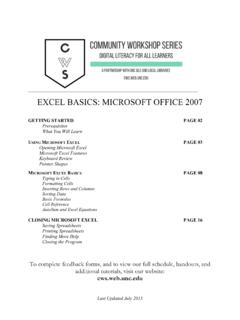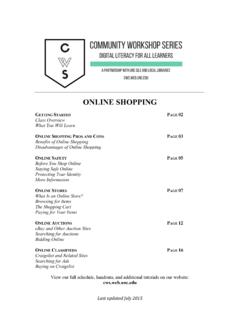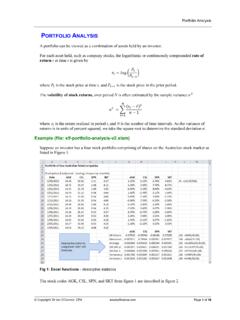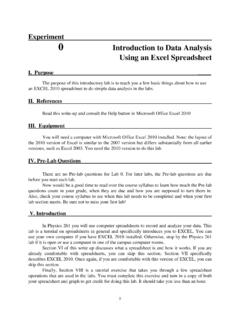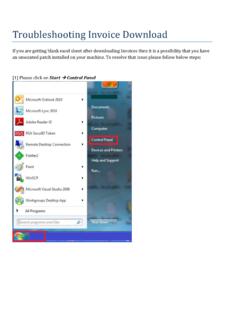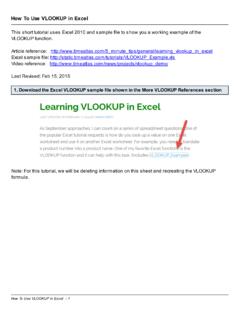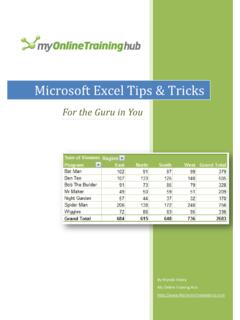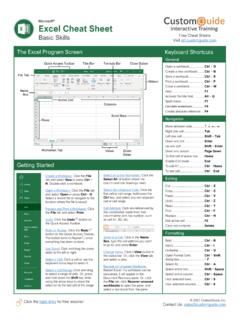Transcription of EXCEL BASICS: MICROSOFT OFFICE 2010
1 Last Updated January 2016 EXCEL BASICS: MICROSOFT OFFICE 2010 GETTING STARTED PAGE 02 Prerequisites What You Will Learn USING MICROSOFT EXCEL PAGE 03 Opening MICROSOFT EXCEL MICROSOFT EXCEL Features Keyboard Review Pointer Shapes MICROSOFT EXCEL BASICS PAGE 09 Typing in Cells Formatting Cells Inserting Rows and Columns Sorting Data Basic Formulas Cell Reference AutoSum and EXCEL Equations CLOSING MICROSOFT EXCEL PAGE 17 Saving Spreadsheets Printing Spreadsheets Finding More Help Closing the Program To complete feedback forms, and to view our full schedule, handouts, and additional tutorials, visit our website: 2 GETTING STARTED Prerequisites: This is a class for beginning computer users. You are only expected to know how to use the mouse and keyboard, open a program, and turn the computer on and off. You should also be familiar with the MICROSOFT Windows operating system.
2 Today, we will be going over the basics of using MICROSOFT EXCEL . We will be using PC desktop computers running the Windows operating system. MICROSOFT EXCEL is part of the suite of programs called MICROSOFT OFFICE , which also includes Word, PowerPoint, and more. Please let the instructor know if you have questions or concerns before the class, or as we go along. You Will Learn How To: Find and open MICROSOFT EXCEL in Windows Use MICROSOFT EXCEL s menu and toolbar Review the keyboard functions Understand the different pointer shapes Type in cells Format cells Insert rows and columns Sort your data Basic formulas Cell references Use Autosum Save worksheets Print worksheets Exit the program 3 USING MICROSOFT EXCEL MICROSOFT EXCEL is an example of a program called a spreadsheet. Spreadsheets are used to organize real world data, such as a check register or a rolodex. Data can be numerical or alphanumeric (involving letters or numbers).
3 The key benefit to using a spreadsheet program is that you can make changes easily, including correcting spelling or values, adding, deleting, formatting, and relocating data. You can also program the spreadsheet to perform certain functions automatically (such as addition and subtraction), and a spreadsheet can hold almost limitless amounts of data a whole filing cabinet s worth of information can be included in a single spreadsheet. Once you create a spreadsheet, you can effortlessly print it (as many copies as you want!), save it for later modifications, or send it to a colleague via e-mail. MICROSOFT EXCEL is a very powerful calculator This handout covers just a small number of its features! MICROSOFT EXCEL is available on both PCs and Macs, so what you learn in class today should be applicable to any computer you use. The program may look slightly different depending on the version and computer that you re using, but MICROSOFT EXCEL will function in the same basic ways.
4 There are other spreadsheet programs out there, including Google Spreadsheets (part of Google Docs), OpenOffice Calc, Apple iWorks Numbers, Lotus 1-2-3, and WordPerfect Quattro. They have many features in common with MICROSOFT EXCEL , and you should feel free to choose any program you prefer. Opening MICROSOFT EXCEL : To get started with MICROSOFT EXCEL (often called EXCEL ), you will need to locate and open the program on your computer. To open the program, point to EXCEL s icon on the desktop with your mouse and double-click on it with the left mouse button. If you don t see the EXCEL icon on your desktop, you ll have to access the program from the Start Menu. Click on the button in the bottom left corner to pull up the Start Menu. You may see the EXCEL icon here, so click on it once with your left button. If you still don t see it, click on All Programs and scroll through the list of programs until you find it.
5 It may also be located in a folder called MICROSOFT OFFICE or something similar it will depend on your specific machine. Click once with your left button to open the program. 4 EXCEL will then open a blank page called Book1. This is an image of the upper-left corner of EXCEL . This box features two important pieces of information: the name of the file that you are currently working on (in this case, Book1 since we have not yet renamed it) and which program you are using ( MICROSOFT EXCEL ). You will see a dark box around one of the lighter color boxes on the spreadsheet. This means that a cell is selected and you will be able to enter information in that space. MICROSOFT EXCEL Features: The Title Bar This is a close-up view of the Title Bar, where file information is located. It shows the name of the file (here, Book1, the default title) and the name of the program ( MICROSOFT EXCEL ). You will be able to name your file something new the first time that you save it.
6 Notice the three buttons on the right side of the Title Bar, controlling the size and closing of the program. The Ribbon Menu System The tabbed Ribbon menu system is how you navigate through EXCEL and access various EXCEL commands. If you have used previous versions of EXCEL , the Ribbon system replaces the traditional menus. At the bottom, left area of the spreadsheet, you will find worksheet tabs. By default, three worksheet tabs appear each time you create a new workbook. On the bottom, right area of the spreadsheet you will find page view commands, the zoom tool, and the horizontal scrolling bar. 5 The File Menu In MICROSOFT OFFICE 2007, there was something called the MICROSOFT OFFICE Button () in the top left-hand corner. In MICROSOFT OFFICE 2010 , this has been replaced with a tab in the Ribbon called File. When you left-click on this tab, a drop-down menu appears. From this menu, you can perform the same functions as were found under the MICROSOFT OFFICE Button menu, such as: Create a new worksheet, open existing files, save files in a variety of ways, and print.
7 6 Quick Access Toolbar On the top left-hand side of the Title Bar, you will see several little icons above the File menu. These let you perform common tasks, such as saving and undoing, without having to find them in a menu. We ll go over the meanings of the icons a little later. The Home Tab The most commonly used commands in EXCEL are also the most accessible. Some of these commands available in the Home Tab are: The Home Tab Toolbar offers options that can change the font, size, color, alignment, organization and style of the text in the spreadsheet and individual cells. For example, the Calibri indicates the FONT of your text, the 11 indicates the SIZE of your text; etc. We will go over how to use all of these options to format your text in a little while. Each of these options expands into a menu if you left-click on the tiny down-arrow in the bottom right corner of the window. This tab works the exact same way as the MS Word Formatting Toolbar.
8 The main difference is that the format changes will only affect the selected cell or cells, all unselected cells remain in the default setting ( Calibri font, size 11 ). Formula Bar The Formula Bar is generally found below the ribbon menu. The left side denotes which cell is selected ( C5 ) and the right side allows you to input equations or text into the selected cell. Font Style Font Name Font Size Font Color Alignment AutoSum Sort 7 There are two ways to input information into a cell. You may either select an individual cell and type the equation or text into the Formula Bar or type the equation or text directly into the selected cell. Equations (for example, =SUM(D5+E5)) will automatically be hidden inside the cell and can only be viewed using the formula bar; the result of the equation will display in the cell. If any written text is longer than the cell width, then the spreadsheet will cover up any portion longer than the cell width.
9 The information will still be in the cell, you just won t be able to see it at all times. Keyboard Review: In order to use EXCEL effectively, you must input commands using both the mouse and the keyboard. The above image of a keyboard should look similar to the keyboard in front of you; learning just a few certain keys will help to improve your efficiency in typing as well as present you with more options within the program. The following is a list of commonly used keys that you may already be familiar with: 1. Backspace: This key deletes letters backwards. 2. Delete: This key deletes letters forward. 3. Shift: This key, when pressed WITH another key, will perform a secondary function. 4. Spacebar: This key enters a space between words or letters. 5. Tab: This key will indent what you type, or move the text to the right. The default indent distance is usually inch. 6. Caps Lock: Pressing this key will make every letter you type capitalized.
10 7. Control (Ctrl): This key, when pressed WITH another key, performs a shortcut. 8. Enter: This key either gives you a new line, or executes a command. 9. Number Keypad: These are exactly the same as the numbers at the top of the keyboard; some people just find them easier to use in this position. 10. Arrow Keys: Like the mouse, these keys are used to navigate through a document or page. 8 Pointer Shapes: As with other MICROSOFT programs, the pointer often changes its shape as you work in EXCEL . Each pointer shape indicates a different mode of operation. This table shows the various pointer shapes you may see while working in EXCEL . 9 MICROSOFT EXCEL BASICS Typing in Cells: Cells are the small rectangular boxes that make up the spreadsheet. The boxes are the intersection of columns (A, B, C, etc.) and rows (1, 2, 3, etc.). To reference a cell, use the column and the row name. For example, the cell in the first column and first row is called A1.

